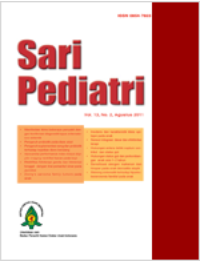Pengukuran Indeks Syok untuk Deteksi Dini Syok Hipovolemik pada Anak dengan Takikardia: telaah terhadap perubahan indeks isi sekuncup
Sari
Latar belakang. Syok merupakan gawat darurat yang sering terjadi pada anak dengan manifestasi klinis awal takikardia sebagai kompensasi atas penurunan indeks isi sekuncup (IIS). Indeks syok (rasio laju jantung terhadap tekanan darah sistolik) berhubungan erat dengan IIS pada orang dewasa dan dapat digunakan menilai beratnya syok serta keberhasilan resusitasi cairan secara sederhana dan murah. Hal ini belum pernah dicoba untuk diterapkan pada anak.
Tujuan. Menilai kemampuan indeks syok sebagai deteksi dini syok hipovolemik pada anak dengan takikardia.
Metode. Uji diagnostik dan studi kuasi eksperimental (the one group pretest-posttest design) pada anak dengan takikardia yang dilakukan resusitasi cairan. Indeks isi sekuncup diukur dengan alat USCOM (ultrasound cardiac output monitor). Indeks syok dan IIS diukur sebelum dan setelah resusitasi cairan. Peningkatan IIS ≥10% setelah resusitasi cairan merupakan baku emas keberhasilan resusitasi cairan.
Hasil. Duapuluh delapan (70%) di antara 40 subjek penelitian memiliki IIS rendah dan indeks syok sebelum resusitasi cairan berkisar antara 1,12-2,04. Duabelas (30%) subjek dengan IIS normal dan indeks syok sebelum resusitasi cairan berkisar antara 1,00-1,74. Tidak terbukti terdapat korelasi antara indeks syok dengan IIS sebelum (p= 0,845; r 0,32) dan setelah resusitasi cairan (p= 0,112; r 0,256). Penurunan indeks syok optimal setelah resusitasi cairan adalah ≥0,02 (IK 95% 0,504 sampai 0,835) dengan sensitivitas 60,71% dan spesifisitas 66,67%.
Kesimpulan. Pengukuran indeks syok tidak terbukti dapat digunakan untuk deteksi dini syok hipovolemik pada anak dengan takikardia.Â
Kata Kunci
Teks Lengkap:
PDFReferensi
Frankel LR, Kache S. Shock. Dalam: Kliegman RM, Behrman RE, Jenson HD, Stanton BF, penyunting. Nelson textbook of pediatrics. Edisi ke 18. Philadelphia: W.B. Saunders Company; 2007. h.413-20.
McNutt S, Denninghoff KR, Temdrup T. Shock: rapid recognition and appropriate ED intervention. Emerg Med Pract 2000;2:1-24.
McKiernan CA, Lieberman SA. Circulatory shock in children: an overview. Pediatr Rev 2005;26:451-9.
Bierley J, Carcillo JA, Choong K, Cornell T, DeCaen A, Deymann A, et al. Clinical practice parameters for hemodynamic support of pediatric and neonatal septic shock: 2007 update from the American College of Critical Care Medicine. Crit Care Med 2009;37:666-85.
Carcillo JA, Wheeler DS, Kooy NW, Shanley TP. Shock: an overview. Dalam: Wheeler DS, Wong HR, Shanley TP, penyunting. Resuscitation and stabilization of the critically ill child. London: Springer–Verlag Limited; 2009. h.89-113.
Yager P, Noviski N. Shock. Pediatr Rev 2010;31:311-9.
Arikan AA, Citak A. Pediatric shock. Signa Vitae. 2008;3:13-23.
Ellender TJ, Skinner JC. The use of vasopressors and inotropes in the emergency medical treatment of shock. Emerg Med Clin N Am 2008;26:759-86.
Kissoon N, Orr RA, Carcillo JA. Updated American College of Critical Care Medicine – Pediatric Advanced Life Support guidelines for manangement of pediatric and neonatal septic shock – relevance to the emergency care physician. Pediatr Emerg Care 2010;26:867-9.
Lemson J, Nusmeler A. Advanced hemodynamic monitoring in critically ill children. Pediatrics 2011;128:560-71.
Han YY, Carcillo JA, Dragotta MA, Bills DM, Watson RS, Westerman ME, et al. Early reversal of pediatric-neonatal septic shock by community physicians is associated with improved outcome. Pediatrics 2003;112:793-9.
Park MK. Pediatric cardiology for practitioners. Edisi ke – 5. Philadelphia: Mosby Elsevier; 2008. h.558-74.
Cattermole GN, Leung M, Mak PS, Chan S, Graham CA, Rainer TH. The normal ranges of cardiovascular parameters in children measured using the ultrasonic cardiac output monitor. Crit Care Med 2010;38:1875-81.
Smith BE. The USCOM and hemodynamics. (Diakses tanggal 20 April 2012). Diunduh dari: http://www.learnhemodynamics.com/hemo/sv.htm.
Wo CC, Shoemaker WC, Appel PL, Bishop MH, Kram HB, Hardin E. Unreliability of blood pressure and heart rate to evaluate cardiac output in emergency resuscitation and critical illness. Crit Care Med 1993;21:218-23.
Rady MY, Rivers EP, Nowak RM. Resuscitation of the critically ill in the ED: responses of blood pressure, heart rate, shock index, central venous oxygen saturation, and lactate. Am J Emerg Med 1996;14:218-25.
Rady MY, Smithline HA, Blake H, Nowak R. A comparison of the shock index and conventional vital signs to identify acute, critical illness in the emergency department. Ann Emerg Med 1994;24:685-90.
Birkhahn RH, Gaeta TJ, Bei R, Bove JJ. Shock index in the first trimester of pregnancy and its relationship to ruptured ectopic pregnancy. Acad Emerg Med 2002;9:115-20
Paladino L, Subramanian RA, Nabors S, Sinert R. The utility of shock index in differentiating major from minor injury. Eur J Emerg Med 2011;18:94-9.
DOI: http://dx.doi.org/10.14238/sp15.5.2014.319-24
Refbacks
- Saat ini tidak ada refbacks.
##submission.copyrightStatement##
##submission.license.cc.by-nc-sa4.footer##
Email: editorial [at] saripediatri.org


Sari Pediatri diterbitkan oleh Badan Penerbit Ikatan Dokter Anak Indonesia
Ciptaan disebarluaskan di bawah Lisensi Creative Commons Atribusi-NonKomersial-BerbagiSerupa 4.0 Internasional.




